 Expanding Opportunities: Toward Inclusive GrowthGDP in South Asia is estimated to grow at 5.6% in fiscal year FY2023 and 5.9% in FY2024, backed by the recovery in services and lower commodity prices. GDP growth in Bangladesh will decelerate to 5.2% in FY2022-2023 due to global economic uncertainty, before recovering to 6.2% in FY2024. In Bhutan, GDP is projected to expand at 4.5% in FY2022-2023 as the further reopening of borders support growth in industry and services. GDP growth in India will moderate to 6.3% in FY2023-2024 following slower growth in consumption. Maldives is seeing a return to the tourism sector's pre-pandemic levels with GDP growth projections in FY2023 at 6.6%. Growth in Nepal will slow to 4.1% in FY2023 following import restrictions, before rising to 4.9% in FY2024. In Sri Lanka, amid fiscal and external imbalances, GDP growth is estimated at -4.3% in FY2023 and 1.2% FY2024. In Southeast Asia, the Myanmar Economic Monitor projects Myanmar's economic recovery accelerating to 3% in the year to September 2023 following growth in industry and services. Author: World Bank Year: 2023 Download Tags: WB, Bangladesh, Bhutan, Sri Lanka, Services, India, Maldives, Myanmar, Nepal Basic Statistics 2023Basic Statistics presents data on development indicators tracking progress toward the Sustainable Development Goals. The publication includes new data for development indicators for 46 economies in Asia and the Pacific, including those for the seven South Asia Subregional Economic Cooperation countries: Bangladesh, Bhutan, India, Maldives, Myanmar, Nepal, and Sri Lanka. Author: Asian Development Bank Year: 2023 Download Tags: Bangladesh, Bhutan, India, Myanmar, Maldives, Nepal, Sri Lanka, Sustainable Development Goals 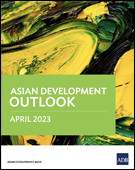 Asian Development Outlook (ADO) April 2023South Asia is projected to grow faster than other subregions in Asia, with real gross domestic product (GDP) estimated at 5.5% in fiscal year (FY) 2023 and 6.1 in FY2024. Growth within South Asia is expected to vary, with India projected to grow by 6.4% in FY2023 and 6.7% in FY2024 behind strong domestic demand. In Bangladesh, GDP growth is estimated at 5.3% in FY2023 owing to global economic disruptions and 6.5% in FY2024. In Bhutan, hydropower production will push up growth to 4.6% in FY2023 and 4.2% in FY2024. Growth in Maldives is estimated at 7.1% in FY2023 and 6.9% in FY2024, supported by a boom in tourism and construction. In Nepal, growth will slow to 4.1% this year before picking up in FY2024 at 5.0% with a recovery in tourism and infrastructure. Sri Lanka is projected to contract at -3.0% in FY2023 before recovering to 1.3% in FY2024 premised on debt relief and key reforms. In Southeast Asia, Myanmar's GDP will rise moderately to 2.8% in FY2023 and 3.2% in FY2024. Author: Asian Development Bank Year: 2023 Download Tags: South Asia, Hydropower, ADB, Bangladesh, Bhutan, India, Maldives, Myanmar, Nepal, Sri Lanka Identifying Challenges and Improving Trade Facilitation in the States of Northeast IndiaThe northeast of India is shares international borders with Bangladesh, Bhutan, Nepal, and Myanmar and acts as a bridge for India's participation in global forums through the Bay of Bengal Initiative for Multisectoral Technical and Economic Cooperation and the South Asia Subregional Economic Cooperation program. This paper highlights challenges in global trade and suggests ways for improving trade with other countries in South Asia and Southeast Asia. Author: Sanchita Basu Das and Soumya Chattopadhyay Year: 2023 Download Tags: India, Trade Facilitation, SASEC, BIMSTEC, Transport, Bangladesh, Bhutan, Nepal, Myanmar 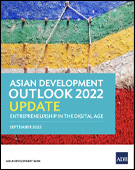 Asian Development Outlook (ADO) 2022 Update: Entrepreneurship in the Digital AgeGrowth forecast in South Asia is projected at 6.5% in fiscal year (FY) 2022 and FY2023. In Bangladesh, gross domestic product (GDP) growth is projected at 7.2% in FY2022 and 6.6% in FY2023, reflecting lower consumption spending. Growth in Bhutan is forecast to grow at 4.5% in FY2022 and 4.0% in FY2023 as government investment continues as a key driver of growth. In India, weaker than expected global demand is expected to affect growth, projected at 7.0% for FY2022 and 7.2% for FY2023. GDP growth in Maldives is forecast at 8.2% in FY2022 and 10.4% in FY2023 with continued tourism arrivals. In Nepal, GDP is projected at 5.8% in FY2022 and 4.7% in FY2023, affected in part by needed policy tightening to address rapid rise in imports. Contractions are projected for Sri Lanka, -8.8% in FY2022 and -3.3% in FY2023, likely resulting from severe macroeconomic challenges, including the impact of the ongoing crisis. In Southeast Asia, Myanmar's GDP is forecast at 2.0% in FY2022 and 2.6% in FY2023 owing to an improvement in economic activity. Author: Asian Development Bank Year: 2022 Download Tags: ADB, Bangladesh, Bhutan, India, Maldives, Myanmar, Nepal Basic Statistics 2022Basic Statistics presents economic, environmental, and social indicators used to track progress toward the Sustainable Development Goals. The publication includes new data for development indicators for 46 economies in Asia and Pacific, including those for the seven South Asia Subregional Economic Cooperation countries: Bangladesh, Bhutan, India, Maldives, Myanmar, Nepal, and Sri Lanka. Author: Asian Development Bank Year: 2022 Download Tags: Bangladesh, Bhutan, India, Maldives, Myanmar, Nepal, Sri Lanka, Trade, Sustainable Development Goals, Renewable Energy 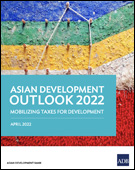 Asian Development Outlook (ADO) 2022: Mobilizing Taxes for DevelopmentGrowth in South Asia is projected to remain strong at 7.0% in FY2022 and 7.4% in FY2023 as the region’s economies try to catch up to pre-pandemic levels. In Bangladesh gross domestic product (GDP) growth is projected at 6.9% in FY2022. Growth in FY2023, projected at 7.1%, will be driven by private consumption. Bhutan is forecast to grow at 4.5% in FY2022. Growth will accelerate to 7.5% in FY2023 with the reopening of international tourism in the country. India is forecast to grow at 7.5% in FY2022 and 8.0% in FY2023, buoyed by strong investment growth. GDP growth in Maldives is forecast at 11.0% in FY2022 and 12.0% in FY2023 with continued tourism arrivals. In Nepal, fiscal stimulus and wider vaccination coverage will support growth, projected at 3.9% in FY2022 and 5.0% in FY2023. Sri Lanka's growth is forecast to slow to 2.4% in FY2022 and pick up to 2.5% in FY2023 amid low foreign exchange reserves. In Southeast Asia, Myanmar’s economy is forecast to contract in FY 2022 on protracted political instability. Myanmar GDP is forecast at -0.3% in FY2022 and 2.6% in FY2023. Author: Asian Development Bank Year: 2022 Download Tags: ADB, Bangladesh, Bhutan, India, Nepal, Sri Lanka, Maldives, Myanmar Basic Statistics 2021Basic Statistics 2021 presents development indicators—tracking the progress made by countries in achieving the Sustainable Development Goals. It includes data for 46 economies in Asia and the Pacific, including those for the seven South Asia Subregional Economic Cooperation countries: Bangladesh, Bhutan, India, Maldives, Myanmar, Nepal, and Sri Lanka. Author: Asian Development Bank Year: 2021 Download Tags: Bangladesh, Bhutan, India, Maldives, Myanmar, Nepal, Sri Lanka, Trade, Sustainable Development Goals, Renewable Energy Basic Statistics 2020Basic Statistics presents select economic, environmental, and social indicators used to track progress toward the Sustainable Development Goals. It includes new data for development indicators for 46 economies in the Asia and Pacific region, including those for the seven South Asia Subregional Economic Cooperation countries: Bangladesh, Bhutan, India, Maldives, Myanmar, Nepal, and Sri Lanka. Author: Asian Development Bank Year: 2020 Download Tags: Sustainable Development Goals, Bangladesh, Bhutan, India, Maldives, Myanmar, Nepal, Sri Lanka Asian Development Outlook (ADO) 2020: What Drives Innovation in Asia?Growth in developing Asia is forecast to slow to 2.2% in fiscal year (FY) 2020 due to the effects of the global health emergency. In South Asia, growth will decelerate to 4.1% in FY2020 and rebound to 6.0% in FY2021 following a projected revival in India. Bangladesh is projected to grow by 7.8% this fiscal year and 8.0% in FY2021. GDP growth in Bhutan, despite lower tourist arrivals, will accelerate on high government spending. Growth in Maldives and Sri Lanka will be constrained this year due to weaker tourism. In Nepal, the outlook is for moderating growth. In Southeast Asia, Myanmar growth is expected to slow in FY2020 and pick up in FY2021. Author: Asian Development Bank Year: 2020 Download Tags: ADB, Bangladesh, Bhutan, India, Maldives, Myanmar, Nepal, Sri Lanka, Tourism, FDI World Bank East Asia and Pacific Economic Update, October 2019: Weathering Growing RisksAmid weakening global demand and policy uncertainty regarding trade tensions, growth in developing East Asia and Pacific region slowed in the first half of 2019. There is a need to address vulnerabilities and preserve economic dynamism in developing economies in the region. In Myanmar, GDP growth will reach 6.8% in 2021/2022 with the projected pick-up in agriculture. Policy measures to encourage investment, such as those for the energy sector, are expected to strengthen Myanmar’s manufacturing and construction sectors. Author: World Bank Year: 2019 Download Tags: Energy, Investment, Myanmar, WB Borders without Barriers: Facilitating Trade in SASEC CountriesBorders without Barriers presents an analysis of the state of trade facilitation in member countries of the South Asia Subregional Economic Cooperation (SASEC) program. The book includes an analysis of the state of trade facilitation in Bangladesh, Bhutan, India, Nepal, and Sri Lanka, as well as in Maldives and Myanmar. It identifies trade facilitation priorities in SASEC countries: implementation of trade facilitation agreements and other conventions; logistics and infrastructure development and regulatory reforms; coordinated border management; and institutions and capacity development. Author: Asian Development Bank Year: 2019 Download Tags: ADB, SASEC, Trade Facilitation Agreement, Bangladesh, Bhutan, India, Maldives, Myanmar, Nepal, Sri Lanka, ADB RCI Bridging the East: Trade and Transport Connectivity in the Bay of Bengal RegionBangladesh, Bhutan, India, and Nepal Motor Vehicles Agreement aims to reap the trade and economic potentials of the countries of South Asia. This study identifies hurdles to the successful implementation of the agreement through evidence-based advocacy and dialogue. The study highlights issues related to infrastructure, political economy, gender, and livelihood. Author: CUTS International Year: 2019 Download Tags: Trade, Transport, BBIN, BBIN Motor Vehicles Agreement, Bangladesh, India, Bhutan, Myanmar, Nepal 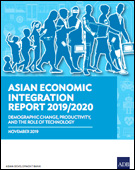 Asian Economic Integration Report 2019/2020: Demographic Change, Productivity, and the Role of TechnologyThis report reviews economic cooperation and integration in Asia and the Pacific. It reports that in 2018, the South Asia Subregional Economic Cooperation (SASEC) focused on reducing gaps in multimodal connectivity among its member countries. By the end of 2018, 52 ADB-financed projects worth $11.36 billion had been committed to SASEC projects, with an additional $106.44 million in 81 technical assistance grants. SASEC nodal officials and working groups met in Singapore in March 2018 to update the SASEC operational plan. The operational plan identified 77 projects ($45.6 billion) to be financed by SASEC members, ADB, and development partners. A holistic approach under the operational plan will build transport links with Southeast Asia and East Asia and expand regional trade markets. Author: Asian Development Bank Year: 2019 Download Tags: ADB, Regional Cooperation, SASEC, Trade Facilitation, Transport, Bangladesh, Bhutan, India, Maldives, Myanmar, Nepal, Sri Lanka Maritime Cooperation in SASEC: South Asia Subregional Economic CooperationMost South Asia Subregional Economic Cooperation (SASEC) countries rely on maritime transport for international trade. Stronger maritime relations are crucial to achieve the economic growth potential for the subregion. This report looks at how countries can strengthen international trade by improving maritime cooperation among the SASEC countries, comprised of Bangladesh, Bhutan, India, Maldives, Myanmar, Nepal, and Sri Lanka. It gives an overview of the SASEC maritime sector and identifies collaboration initiatives that could address key challenges. Author: Asian Development Bank Year: 2019 Download Tags: Transport, Trade Facilitation, Bangladesh, Bhutan, India, Maldives, Myanmar, Nepal, Sri Lanka, ADB RCI Asian Development Outlook (ADO) 2019 Update: Fostering Growth and Inclusion in Asia's CitiesGrowth in developing Asia remains strong despite the slowing down of international trade and a weakening of investments. In South Asia, growth momentum has slowed, with growth forecasts lowered to 6.2% for 2019 and retained at 6.7% for 2020. Growth in India has softened but is expected to bounce back to 7.2% in 2020. Bangladesh and Nepal performed better than projected. Bhutan’s growth slowed to 5.3% in fiscal year (FY) 2019 due to a decline in hydroelectric generation. Growth projection for FY2020 is retained at 6.0%. In Sri Lanka, growth forecast has been lowered for 2019 and 2020. Forecasts for Maldives is retained as tourist arrivals increased in the first half of 2019. In Southeast Asia, growth projections for Myanmar has been retained. Author: Asian Development Bank Year: 2019 Download Tags: Hydropower, ADB, Bangladesh, Bhutan, India, Maldives, Myanmar, Nepal, Sri Lanka Basic Statistics 2019Basic Statistics presents select economic, environmental, and social indicators used to track progress toward the Sustainable Development Goals. It includes indicators for development indicators for 46 economies in the Asia and Pacific region, including those for the seven SASEC countries: Bangladesh, Bhutan, India, Maldives, Myanmar, Nepal, and Sri Lanka. Author: Asian Development Bank Year: 2019 Download Tags: Bangladesh, Bhutan, India, Maldives, Myanmar, Nepal, Sri Lanka, Trade, Sustainable Development Goals, Energy Economic and Social Survey of Asia and the Pacific 2019: Ambitions beyond GrowthThe Asia-Pacific region needs an estimated $1.5 trillion per year to end poverty and hunger, provide basic health care, quality education, enabling infrastructure, and clean energy for all, and for climate action and living in harmony with nature. Available public and private resources make these ambitions affordable for most countries in the region. However, development partnerships and regional cooperation are needed for all countries to achieve these “ambitions beyond growth.” Author: United Nations Economic and Social Commission for Asia and the Pacific Year: 2019 Download Tags: Sustainable Development Goals, Bangladesh, Bhutan, India, Nepal, Maldives, Myanmar, Sri Lanka, Trade, Energy 2018 Development Effectiveness ReviewThis report looks at the Asian Development Bank’s (ADB) performance in achieving the goals set out in ADB’s Strategy 2020. In its South Asia operations, ADB supported the linking of countries through transport connectivity. ADB has committed $180 million to rehabilitate the Kanchanpur–Kamala section of the East–West Highway in Nepal to promote safety and transport connectivity. It is also committed to a $150 million project through the South Asia Subregional Economic Cooperation Road Connectivity Investment Program to upgrade a section of the Asian Highway connecting Manipur, India, to Myanmar and construct an international bridge between India and Nepal. Author: Asian Development Bank Year: 2019 Download Tags: ADB, India, Jobs, Myanmar, Nepal, SASEC, Transport, Road Renewable Capacity Statistics 2019This report provides renewable energy statistics for 2009–2018. It includes figures on total renewable energy capacity installed and connected by energy source (hydropower, wind energy, solar energy, etc.). It gives figures for capacity per region and per country, including those for Bangladesh, Bhutan, India, Maldives, Myanmar, Nepal, and Sri Lanka. Author: International Renewable Energy Agency Year: 2019 Download Tags: Renewable Energy, Bangladesh, Bhutan, India, Maldives, Myanmar, Nepal Asian Development Outlook (ADO) 2019: Strengthening Disaster ResilienceDeveloping Asia is projected to grow at 5.7% in 2019 and 5.6% in 2020. South Asia is projected to bounce back in 2019 and 2020 from the previous year’s slowdown. India’s growth is expected to pick up to 7.2% in 2019 (from 7.0% in the previous year) on recovery in agriculture and strong domestic demand. Bangladesh is projected to grow by 8.0% in 2019. Bhutan is expecting modest growth while the outlook for Maldives is for growth to moderate. Nepal should expect stable growth in 2019 while Sri Lanka is projected to recover moderately. Inflation in South Asia is projected to rise to 4.7% in 2019. Growth should pick up in Myanmar in Southeast Asia. Author: Asian Development Bank Year: 2019 Download Tags: ADB, South Asia, Bangladesh, Bhutan, India, Myanmar, Maldives, Nepal, Sri Lanka BIMSTEC and Japan: Exploring Prospects for Renewed CooperationThe Bay of Bengal region is rising as an economic and strategic hub, with the Bay of Bengal Initiative for Multi-Sectoral Technical and Economic Cooperation (BIMSTEC) playing a key role in promoting growth and development in the region. BIMSTEC is also being seen as a potential driver of integration between South Asia and Southeast Asia. Given Japan's relationship with BIMSTEC nations, this brief makes a case for deeper engagement between Japan and BIMSTEC. The benefits could include cooperation in infrastructure, connectivity, and energy projects. A free trade agreement between the two entities would also be mutually beneficial. Author: Vindu Mai Chotani Year: 2018 Download Tags: ASEAN, Bangladesh, Bhutan, BIMSTEC, Connectivity, India, Myanmar, Nepal, Sri Lanka, Free Trade Agreements Basic Statistics 2018Basic Statistics presents development indicators for 45 economies in the Asia and Pacific region, including those for the seven SASEC countries, Bangladesh, Bhutan, India, Maldives, Myanmar, Nepal, and Sri Lanka. It presents selected core indicators such as international and national poverty rates, inflation, and current account balance. It also presents information on indicators related to land, population, sustainable development goals, national accounts, money, balance of payments, reserves, external debt, and central government finance. Author: Asian Development Bank Year: 2018 Download Tags: Energy, ADB, Trade, Sustainable Development Goals, Bangladesh, Bhutan, India, Maldives, Myanmar, Nepal, Sri Lanka 2017 Development Effectiveness ReviewThis report serves as the Asian Development Bank’s (ADB) tool for monitoring and strengthening its progress. In South Asia, ADB’s $1.3 billion commitment to regional cooperation and integration (RCI) were spread across South Asia Subregional Economic Cooperation (SASEC) program’s priority areas: transport, energy, trade facilitation, and economic corridor development. Project preparation work will expand the $5 billion pipeline for RCI in the subregion with 26 projects planned for approval. SASEC finance ministers endorsed a joint vision of regional cooperation and connectivity. Myanmar’s addition to SASEC improved cooperation prospects between South and Southeast Asian subregions. Author: Asian Development Bank Year: 2018 Download Tags: ADB, Myanmar, SASEC, Transport, Economic Corridor Development East Asia Pacific Economic Update, April 2018: Enhancing PotentialEast Asia and Pacific (EAP) grew slightly faster than anticipated in 2017, with growth in Myanmar rebounding slightly at 6.4% due to strong exports. Amid risks to macroeconomic stability, EAP countries must enhance trade facilitation and integration, improve education systems, and upgrade capabilities of workers and managers. Author: World Bank Year: 2018 Download Tags: Exports, GDP, India, Manufacturing, Myanmar, Poverty Reduction, Trade Facilitation, WB Asian Development Outlook (ADO) 2018: How Technology Affects JobsDeveloping Asia is forecast to expand by 6.0% in 2018 and 5.9% in 2019. Growth in South Asia is expected to be revived after a two-year slowdown. India is expected to bounce back to 7.3% in 2018 and 7.6% in 2019 owing to the effects of tax and banking reforms and corporate deleveraging. Growth will be strong in the rest of South Asia, with a forecast of 7.0% in 2018 and 7.2% in 2019, but expansion will be affected in Bangladesh and Sri Lanka following a need to carry out revenue-enhancing fiscal reform and to strengthen economic policy. Inflation forecast in South Asia is 4.7% in 2018 and raised to 5.1% in 2019. Author: Asian Development Bank Year: 2018 Download Tags: ADB, Bangladesh, Bhutan, India, Employment, Jobs, Maldives, Myanmar, Nepal, Sri Lanka, Technology Renewable Capacity Statistics 2018This publication provides statistics on renewable power generation capacity for the last decade. It gives figures for global capacity, capacity per region, and capacity per country, including those for Bangladesh, Bhutan, India, Maldives, Myanmar, Nepal, and Sri Lanka. Figures include those for total energy generation capacity, total renewable capacity, and capacity by energy source (hydropower, wind energy, solar energy, etc.). Author: International Renewable Energy Agency Year: 2018 Download Tags: Hydropower, Renewable Energy, Bangladesh, Bhutan, India, Maldives, Myanmar, Nepal, Sri Lanka Global Investment Competitiveness Report 2017/2018: Foreign Investor Perspectives and Policy ImplicationsThis report provides analytical insights and empirical evidence on foreign direct investment’s (FDI) drivers and contributions to economic transformation. Data are categorized by sector and geographic origin and destination of investment, including analysis for SASEC countries using data for Bangladesh, Bhutan, India, Myanmar, Nepal, and Sri Lanka. The report explores the potential of FDI to create growth for local firms, assesses the effectiveness of fiscal incentives in attracting FDI, and gives practical recommendations to developing countries. Author: World Bank Group Year: 2018 Download Tags: Bangladesh, Bhutan, FDI, India, Nepal, Sri Lanka, Trade, WB, Myanmar Trade and Trade Facilitation along the Belt and Road Initiative CorridorsThis paper reviews the current state of trade and trade facilitation among the countries along the six corridors under the Belt Road Initiative (BRI), and looks at the potential impact of infrastructure development on trade. It explores at the Bangladesh-China-India-Myanmar (BCIM) corridor, and reviews trade growth, tariff rates, logistics performance index, ease of trading across borders, and other indicators in those countries. Author: Bala Ramasamy, Matthew Yeung, Chorthip Utoktham, and Yann Duval Year: 2017 Download Tags: Bangladesh, Economic Corridor Development, India, Myanmar, Trade Facilitation Regional Cooperation and Integration in Asia and the Pacific: Implementation of the Operational Plan for Regional Cooperation and Integration, 2016–2020─Corporate Progress Report 2017Regional cooperation and integration (RCI) is a valuable means for attaining national development goals. This report reviews ADB’s progress in implementing its Operational Plan for Regional Cooperation and Integration, 2016–2020, and identifies areas for improvement. It takes a close look at progress in connectivity, competitiveness, and regional public goods and collective action through projects such as the Nepal: SASEC Customs Reform and Modernization for Trade Facilitation Program. Author: Asian Development Bank Year: 2017 Download Tags: Nepal, Energy, Trade, Customs, Myanmar, Regional Cooperation, Regional Integration, SASEC, Trade Facilitation 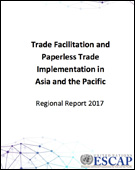 Trade Facilitation and Paperless Trade Implementation in Asia and the Pacific - Regional Report 2017Paperless trade reduces trade costs and enables trade to drive growth and sustainable development. This report shares results of the global survey on trade facilitation and paperless trade implementation, covering 44 countries in Asia and the Pacific. It covers 47 trade facilitation measures, including those involving general trade, paperless trade, cross-border paperless trade, transit, and trade for small and medium-sized enterprises. The report gives an overview of trade facilitation implementation in South and Southwest Asia, and includes Bangladesh, India, and Myanmar in its analysis of transit measures in Asia and the Pacific. Author: United Nations Economic and Social Commission for Asia and the Pacific Year: 2017 Download Tags: UNESCAP, Bangladesh, India, Least Developed Countries, Maldives, Myanmar, Small and Medium Enterprise, Trade Facilitation Agreement, Transport Facilitation, WTO ESCAP Newsletter - 2017 SeptemberThe ESCAP Newsletter is a monthly recap of the events and other activities of the United Nations Economic and Social Commission for Asia and the Pacific (UNESCAP). This issue highlights the ASEAN-India partnership and how it could benefit the Asia-Pacific region. Dr. Shamshad Akhtar, Executive Secretary, UNESCAP, talks about the importance of sustainable development and regional cooperation and integration. The issue also features a story on strengthening technical cooperation between UNESCAP and Myanmar. Author: United Nations Economic and Social Commission for Asia and the Pacific Year: 2017 Download Tags: ASEAN, India, Myanmar, Regional Cooperation, Regional Integration, UNESCAP The Asian Economic Integration Cooperation Agreement: Lessons for Economic and Social DevelopmentThis paper focuses on the impact of regional integration on development and poverty reduction in the Association of Southeast Asian Nations (ASEAN) economic community. It examines economic growth, rapid trade, and investment expansion and looks at challenges presented by the deterioration in trade balances in Cambodia, Laos, Myanmar, and Vietnam. It also explores the role of regional integration in addressing the development gap in ASEAN countries. Author: Amelia U. Santos-Paulino Year: 2017 Download Tags: ASEAN, Free Trade Agreements, Least Developed Countries, Myanmar, Regional Cooperation, Regional Integration, WTO Asian Development Bank and Myanmar: Fact SheetUpdated yearly, this Asian Development Bank (ADB) Fact Sheet provides social and economic indicators on Myanmar, as well as information on ADB operations in the country and contact details. ADB is supporting Myanmar in promoting inclusive and sustainable economic growth, with investments focusing on infrastructure (in energy, transport, and urban and water services), education, and rural development. Regional cooperation will remain one of the key priorities. Author: Asian Development Bank Year: 2017 Download Tags: ADB, Myanmar, Sustainability, Infrastructure, Energy, Transport, Regional Cooperation 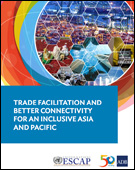 Trade Facilitation and Better Connectivity for an Inclusive Asia and PacificThis report investigates the evolution of trade costs, examines trade facilitation and paperless trade implementation, and highlights key initiatives in South Asia, including efforts by members of the South Asia Subregional Economic Cooperation (SASEC). The SASEC Trade Facilitation and Transport Working Group agreed to expand assistance to trade facilitation through technical assistance to support more efficient, transparent, secure, and service-oriented processing of cross-border trade across South Asia. Through 2025, the SASEC connectivity agenda will be better aligned with the frameworks of South Asian Association for Regional Cooperation and the Bengal Initiative for Multi-Sectoral Technical and Economic Cooperation. To help establish a trade and transport facilitation monitoring mechanism, Bangladesh, Bhutan, and Nepal conducted studies that reviewed trade and transport procedures, analyzed bottlenecks, and gave recommendations on trade and transport facilitation. Author: Asian Development Bank and United Nations Economic and Social Commission for Asia and the Pacific Year: 2017 Download Tags: ADB, Bangladesh, Bhutan, BIMSTEC, Maldives, Nepal, SAARC, India, Myanmar, SASEC, South Asia, Sri Lanka, Trade Facilitation, Transport, UNESCAP, ADB RCI Myanmar’s Integration with the WorldMyanmar only recently began participating in global trade and investment. It has large untapped potential for trade and investment in agriculture and forest-based industries, and services, such as tourism and information technology. This book examines Myanmar’s access to the global market and examines the implication of Myanmar’s democratic transition, the progress of Myanmar’s industry and infrastructure, its international linkages, and options for increased integration in regional economic groups. The book also analyzes how Myanmar could exploit global value chains. Author: Prabir De and Ajitava Raychaudhuri, editors Year: 2017 Download Tags: Agriculture, Global Value Chains, Infrastructure, Investment, ICT, Myanmar, Regional Integration, Trade Myanmar’s Engagement in Regional Integration: Status and Way Forward (AWP No. 169)Myanmar strategic position connects Asia’s three big markets—Association of Southeast Asian Nations, China, and India. Since 2011, Myanmar has laid down economic reforms that are unlocking the country’s potential. This working paper discusses Myanmar’s participation in regional partnerships, such as the South Asia Subregional Economic Cooperation, which it joined in 2017. It argues that such partnerships are essential in building Myanmar’s infrastructure and speeding up its growth. Author: Prabir De Year: 2017 Download Tags: ADB, ASEAN, India, Myanmar, Regional Cooperation, Regional Integration, SASEC, UNESCAP 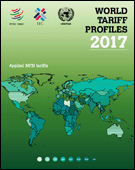 World Tariff Profiles 2017World Tariff Profiles is a joint publication of the World Trade Organization (WTO), International Trade Centre, and the United Nations Conference on Trade and Development devoted to information on market access for goods. It contains comprehensive data on tariffs and non-tariff measures imposed by over 170 countries and Customs territories. This year’s edition takes a close look at export diversification, analyzing to what extent economies have diversified their exports over time. Many countries make it a policy to diversify exports to obtain bigger market shares. An overview of export diversification shows how India, Myanmar, Sri Lanka, Bangladesh, and Bhutan have grown in the last two decades. Bangladesh in particular has achieved significant increase in terms of both product coverage and market reach. Author: World Trade Organization, International Trade Centre, and the United Nations Conference on Trade and Development Year: 2017 Download Tags: Bangladesh, Bhutan, Export, India, Maldives, Myanmar, Nepal, Sri Lanka, Tariffs, Trade, UNCTAD, WTO World Trade Statistical Review 2017The World Trade Statistical Review looks at the last 10 years and examines the latest developments in world trade, with a detailed analysis of the most recent trends for trade in goods and services. The book gives information on the participation of India, Bangladesh, and other South Asian economies in world trade, and highlights trends in the use of trade-facilitating measures. It also gives information on the implementation of the WTO Trade Facilitation Agreement and regional trade agreements, such as the South Asian Free Trade Arrangement. Author: World Trade Organization Year: 2017 Download Tags: Export, Least Developed Countries, Aid for Trade, SAFTA, South Asia, Trade Facilitation, WTO, Bangladesh, Bhutan, India, Maldives, Myanmar, Nepal, Sri Lanka Regional Cooperation for Sustainable Energy in Asia and the PacificCountries in the Asia-Pacific region face multiple energy-related challenges, which are driving transformation of energy systems. Addressing these energy challenges is an integral part of implementing the 2030 Agenda for Sustainable Development, including ensuring access to affordable, reliable, sustainable, and modern energy for all. This report analyzes challenges in the Asia-Pacific region and its efforts to accelerate the energy transition to achieve Sustainable Development Goal 7. Author: United Nations Economic and Social Commission for Asia and the Pacific Year: 2017 Download Tags: Asia-Pacific, Energy, Sustainability, Sustainable Development Goals, UNESCAP, Bangladesh, Bhutan, India, Maldives, Myanmar, Nepal, Sri Lanka 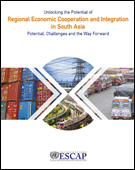 Unlocking the Potential of Regional Economic Cooperation and Integration in South AsiaAt a modest 6% of total trade, intraregional trade in South Asia stands at less than one third of its full potential. Trade barriers and inadequate infrastructure have cost South Asia over US $54 billion per year in lost export opportunities. With 309 million people living on less than $1.90 a day—the largest concentration of poverty in the world—South Asia should urgently pursue broad-based regional economic cooperation that could enable effective responses to the subregion’s developmental challenges. This report examines the state of economic integration in South Asia and identifies potential areas for further strengthening subregional linkages. It provides recommendations on policy actions to increase market integration, improve connectivity, boost investment in infrastructure development, and tackle shared vulnerabilities and risks. It calls for the consolidation and upgrading of existing trade and investment cooperation initiatives into a South Asia Comprehensive Economic Partnership. Author: United Nations Economic and Social Commission for Asia and the Pacific Year: 2017 Download Tags: BIMSTEC, Investment, Regional Cooperation, SAARC, South Asia, Sustainability, Sustainable Development, Trade, UNESCAP, Bangladesh, Bhutan, India, Maldives, Myanmar, Nepal, Sri Lanka The Little Data Book on Information and Communication TechnologyThis book presents quick indicators for more than 200 countries showing data on key indicators of information and communications technology (ICT), including access, quality, affordability, efficiency, sustainability, and applications. It includes data for Bangladesh, Bhutan, India, Maldives, Myanmar, Nepal, and Sri Lanka. Author: World Bank and International Telecommunications Union Year: 2017 Download Tags: Bangladesh, Bhutan, ICT, India, Maldives, Myanmar, Nepal, Sri Lanka, South Asia, WB 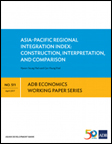 Asia-Pacific Regional Integration Index: Construction, Interpretation, and ComparisonDeeper regional integration expands markets, helps maximize the efficiency of resource allocation, and boosts productivity and investment opportunities, all serving stronger economies. This study proposes a regional integration index for Asia and the Pacific, the Asia-Pacific Regional Integration Index (APRII), comprising 26 indicators that measure various aspects of regional integration along six dimensions: trade and investment integration, money and finance integration, regional value chains, infrastructure and connectivity, free movement of people, and institutional and social integration. In the overall APRII, India ranks 14th—scoring closely to the Asia region integration average of 0.473—and scores highest on regional value chains and institutional and social integration. Nepal ranks 15th, scoring highest on regional value chains and trade and investment integration. Bangladesh and Sri Lanka rank 18th and 20th, respectively, and score highest on regional value chains. Maldives ranks 21st, scoring highest on free movement of people. Myanmar and Bhutan ranks 26th and 27th, and both score highest on trade and investment integration. In the overall regional integration indexes of selected Asian subregions, South Asia ranks 4th. Author: Hyeon-seung Huh, Cyn-Young Park Year: 2017 Download Tags: Regional Integration, Nepal, Bangladesh, Maldives, Myanmar, Bhutan Basic Statistics 2017Basic Statistics 2017 contains development indicators for 45 economies in the Asia and Pacific Region, including the seven SASEC countries, Bangladesh, Bhutan, India, Maldives, Myanmar, Nepal, and Sri Lanka. It includes selected indicators of the Sustainable Development Goals (SDGs) such as the proportion of population living below $1.90 (PPP) a day, proportion of population with access to electricity, renewable energy share in the total final energy consumption, unemployment rate, total official flows for infrastructure, and trade balance. Author: Asian Development Bank Year: 2017 Download Tags: Energy, Trade Facilitation, Transport, Sustainable Development Goals, Bangladesh, Bhutan, India, Maldives, Myanmar, Nepal, Sri Lanka Implications of Brexit to the Asia-Pacific Region: with a Focus on Least Developed Countries (Trade Insights: Issue No. 20)This issue of Trade Insights, published by United Nations Economic and Social Commission for Asia and the Pacific, discusses how possible Brexit scenarios could adversely affect least developed countries in the Asia-Pacific region. Simulation results show that potential reduction in exports to the United Kingdom for fish, clothes, textiles, footwear, and other key items can range from 16% to 50% of their current export value. According to the study, countries heavily exposed to Brexit-induced risks must analyze the extent of such impact and engage the United Kingdom in discussions in order to limit negative impact. Author: Louis Graham, Arun Jacob, and Anders K. Møller Year: 2017 Download Tags: Asia-Pacific, Least Developed Countries, South Asia, Trade, UNESCAP, India, Bangladesh, Maldives, Myanmar, Nepal, Sri Lanka Facilitate Trade for Development: Aid for Trade The Aid for Trade program has been providing support to developing economies in tackling obstacles to growth through better facilitation of trade in the last 10 years. Since its launch in 2006, a total of $308 billion has been disbursed to finance aid-for-trade programs and projects, which are working to reduce trade and transport costs, promote trade expansion, and achieve economic and social objectives. As high trade costs persist in keeping developing countries from fully exploiting their trade and development potential, the Aid for Trade program remains highly relevant, and will help developing economies, including landlocked and small and vulnerable economies, achieve the 2030 Agenda for Sustainable Development. Author: William Hynes and Frans Lammersen Year: 2017 Download Tags: Trade, Development, Aid for Trade, Trade Facilitation, Transport, Bangladesh, Bhutan, Myanmar, Nepal, Least Developed Countries Renewable Energy Sector in Emerging Asia: Development and Policies (TIID Working Paper No. 1/2017)Rapid economic growth in emerging Asia has led to a critical increase of greenhouse gas emissions. Transitioning to renewable energy sources would help reduce emissions. However, massive investment is needed to make that transition. According to this paper, targeted policy interventions are needed to facilitate trade and investment in the renewable energy sector and create “green jobs” in the low-carbon and resource-efficient sectors. Author: Masato Abe, Candice Lea Marie Branchoux, Jaewon Kim Year: 2017 Download Tags: Bangladesh, Energy, Governance, Hydropower, Employment, India, Myanmar, Sustainability, UNESCAP 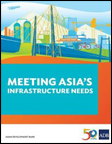 Meeting Asia's Infrastructure NeedsThis report estimates infrastructure investment needs in Asia and the Pacific for 2016-2030, updating the Asian Development Bank's assessment for 2010-2020 published in 2009. The report places developing Asia's investment needs at $26 trillion to maintain its growth momentum, eradicate poverty, and respond to climate change. While developing Asia's infrastructure, including its transport network and electricity generation capacity, has improved significantly over the years, it remains far from adequate – lack of reliable power supply continues to constrain economic growth and traffic congestion results in lost productivity, wasted fuel, and human stress. The report recommends $14.7 trillion investment for power and $8.4 trillion for transport. South Asia requires investments valued at 8.8% of gross domestic product. Author: Asian Development Bank Year: 2017 Download Tags: Asia, South Asia, Energy, Transport, Bangladesh, Bhutan, ADB, India, Maldives, Myanmar, Sri Lanka, Nepal 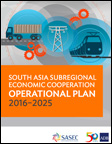 South Asia Subregional Economic Cooperation Operational Plan 2016-2025The SASEC Operational Plan 2016–2025 embodies the strategic objectives and operational priorities of the SASEC Program for the next decade. It expands the SASEC Program's focus beyond intraregional cooperation to developing links with Southeast and East Asia, thus widening the scope of transport, trade facilitation, and energy cooperation. Economic and industrial corridor development, which will arise from improved connectivity, has been introduced as a priority initiative. SASEC 2025 is supported by a list of potential projects to be implemented in the subregion during 2016-2025, that will advance the SASEC goals of multi-modal connectivity, energy security and the growth of regional energy markets, and increased intra- and inter-regional trade. An
update to the operational plan was
published in 2020. Author: Asian Development Bank Year: 2016 Download Tags: SASEC, ADB, Trade Facilitation, Economic Corridor, Transport, Myanmar Seaborne Trade between South Asia and Southeast Asia This Asian Development Bank Institute paper examines trade and the main ports around the Bay of Bengal to identify projects that will enable trade and contribute to improved maritime infrastructure. It also reviews the nature of trade and trade patterns, particularly through the Indian East Coast Corridor study. The paper develops further strategic options for seaport adjustment around the Bay of Bengal to support trade evolution, policy assessment, and other constraints. Author: David Wignall, Mark Wignall Year: 2014 Download Tags: Transport, Trade, Ports, ADB, India, Economic Corridor, Bangladesh, Energy, Myanmar, Sri Lanka SASEC BrochureThis promotional brochure is a concise introduction to the South Asia Subregional Economic Cooperation (SASEC) Program, highlighting the main areas of regional cooperation and activity. It includes facts and figures about SASEC projects in transport, trade facilitation, energy, and ICT. Author: Asian Development Bank Year: 2014 Download Tags: SASEC, Trade Facilitation, Regional Cooperation, ICT, ADB, Bangladesh, Bhutan, India, Nepal, Maldives, Sri Lanka, Energy, Transport, Connectivity, Myanmar 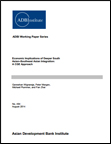 Economic Implications of Deeper South Asian–Southeast Asian Integration: A CGE ApproachHigh tariff and non-tariff barriers, and costly transport links and inefficient trade facilitation measures continue to hamper the growth of trade between South Asia and Southeast Asia. This paper explores whether potential gains from improved connectivity—via Myanmar as inter-regional bridge—justify a high level of investment. Using an advanced computable general equilibrium (CGE) model, reduction of inter-regional tariffs, decreasing of non-tariff barriers by 50%, and cutting down of trade costs between South Asia and Southeast Asia by 15% yields a prediction of 8.9% rise in welfare in South Asia and Southeast Asia, and an increase of 6.4% in gross domestic product by 2030. Author: Ganeshan Wignaraja, Peter Morgan, Michael Plummer, and Fan Zhai Year: 2014 Download Tags: Transport, Trade Facilitation, South Asia, Southeast Asia, Regional Integration, Tariff, Trade, Connectivity, Investment, Myanmar, GDP Asia-Pacific Trade Facilitation Forum: Survey on Trade Facilitation and Paperless TradeConducted jointly by the Asian Development Bank and the United Nations Economic and Social Commission for Asia and the Pacific, this survey provides a status snapshot of trade facilitation in place across 26 countries of the region, including progress towards establishment of national trade facilitation committees, implementation of risk management measures, development of national single windows, and steps taken to move toward paperless trade. It further examines specific issues and challenges in these areas of South East Asian countries, and provides recommendations for improvement. Author: ADB and UNESCAP Year: 2012 Download Tags: Trade Facilitation, Paperless Trade, Bangladesh, Bhutan, India, Nepal, Maldives, Sri Lanka, Customs, Transport Facilitation, Myanmar, National Single Window South Asia- Intra Regional Cooperation: The Way ForwardThis study aims to showcase the benefits of regional integration and recommends strategies for overcoming the many hurdles. Author: Shahid Kardar Year: 2011 Download Tags: Policy, Economic Cooperation, Regional Integration, Development, SAARC, Non-Tariff Measures, Trade Facilitation, SAFTA, India, Bangladesh, Bhutan, Maldives, Nepal, Sri Lanka, BIMSTEC, Myanmar, SASEC, Energy Infrastructure for a Seamless AsiaThe study reviews regional infrastructure being enhanced through regional cooperation in Asia and examines major issues and challenges. It suggests a framework for pan-Asian infrastructure cooperation, anchored on a long-term vision of creating a seamless Asia that will not only enhance the region's competitiveness and extend its global reach, but also help reduce poverty and promote greater environmental sustainability. Author: Asian Development Bank / Asian Development Bank Institute Year: 2009 Download Tags: Regional Cooperation, Regional Integration, Transport, Trade Facilitation, Connectivity, India, Bangladesh, Bhutan, Nepal, Maldives, Sri Lanka, Asian Highway, Trans-Asian Railway Network, Energy, Myanmar |



